Working On the Largest of Canvasses
By Peter Letzelter-Smith
Art is usually on the human scale. It’s of a size that relates to the human body, which is handy because it also means that most artwork will fit neatly on a wall or in a viewing room in an art gallery.
But some artists are driven to work at the extremes of size and go large. Here are a few contemporary artists whose work is on the monumental and who seek to inspire viewers to reinterpret familiar public spaces.
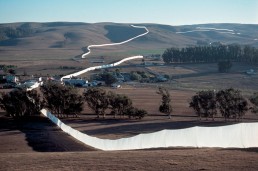
One of the best-known — and controversial — contemporary artists is the tandem of Christo and Jeanne-Claude (they were married and worked in close collaboration until Jeanne-Claude’s death in 2009). Their massive, and in some cases infamous, installation pieces have included wrapping the Berlin’s Reichstag and Paris’s Pont-Neuf bridge with fabric, the Running Fence project that ran 24 miles (39 kilometers) in California, and The Gates piece that was erected in Central Park in New York. As they have explained interviews, their work is meant to lead to new visual interpretations of familiar landscapes.
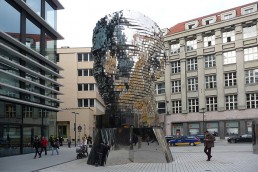
Another controversial artist who works on the large scale is the Czech sculptor David Černý. He first gained widespread notoriety in 1991 when he painted pink a Soviet tank at the Monument to Soviet Tank Crews in Prague, a somewhat more starkly political act of reinterpreting a familiar public space. He’s gone on to have a diverse career, including his Head of Franz Kafka, a huge kinetic sculpture. It is made of 42 polished stainless steel panels that rotate to periodically synchronize into the face of Prague’s most famous author, standing 36 feet (11 meters) in height, and weighing in at 39 tons.
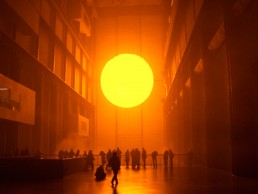
Several contemporary artists take on the challenge of reimagining familiar public spaces less starkly, with a touch of whimsy and the ethereal. The Weather Project by Olafur Eliasson, installed in the Tate’s 500 x 75-foot (152 x 23-meter) Turbine Hall in 2003–2004, was a seemingly simple piece that used its cavernous installation space to create an aura of awe and wonder. A mirror was installed above the area and 200 mono-frequency lamps were arranged in a circle behind a scrim that dominated the far end of the hall, with haze machines — similar to fog machines — creating a mist reminiscent of the dawn’s light. As visitors entered the space they were enveloped in an expansive — yet self-contained — environment that was inspired by the most dominant environment of all, the weather that swathes the Earth’s surface. The Weather Project, according to the Tate’s webpage, “… [took] this ubiquitous subject in his installation as the basis for exploring ideas about experience, mediation, and representation.”
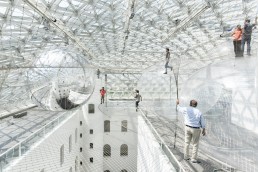
Another installation work that takes over a large public space — but one more directly interactive — is Tomas Saraceno’s In Orbit, which is part of his Cloud Cities series. It hangs above the piazza of K21 Ständehaus in Düsseldorf, Germany, and visitors are not only tempted to look up at the huge 27,000-square-foot (2,500-square-meter) weave of cable resembling a spider’s web but are invited to climb into it. Each visitor that does so changes the contours of the piece and moves any other visitors who have chosen to become “entangled” in it, thereby creating an endless number of variations for an interactive piece installed over 80 feet (25 meters) above the ground.
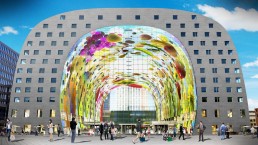
Also levitating above a large public space is the “Sistine Chapel of Rotterdam,” the 36,000-square-foot (3,340-square-meter) “contemporary still life” 3D painting and projected multimedia piece by another duo, Arno & Iris (Arno Coenen and Iris Roskam). It is one of the largest works of visual art ever. Entitled Horn of Plenty, its five layers cover the canvas that is the ceiling of the indoor market De Markthal. A soaring work of vibrant color full of fruits and vegetables and references to historical works of art, it hovers above the vast indoor space, filling the sky for those who have entered the market.
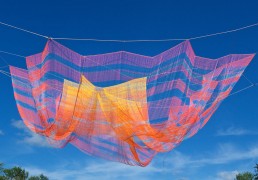
Another artist whose work uses the act of looking upwards at the sky to frame her work is the American sculptor and fiber artist Janet Echelman. She has produced a series of aerial “net” sculptures that hang over public spaces that often include custom nighttime lighting that make them vibrant, shimmering parts of the cityscape. Her best known installations include the 200 x 130-foot (61 x 40-meter) Where We Met in Greensboro, North Carolina, the 145-foot (44-meter) Her Secret Is Patience in Phoenix, Arizona, and the huge She Changes in Porto, Portugal, that hangs from a 148-foot (45-meter) steel ring supported by three support posts that rise as high as 164 feet (50 meters) in the air.

In contrast, a huge work that is provocatively primitive is the sculpture Levitated Mass by Michael Heizer. It is a 340-ton boulder of granite that hovers with a touch of the sinister over a concrete trench at the Los Angeles County Museum of Art. Visitors can walk beneath it, trusting the two steel shelves that are affixed to the trench’s wall to hold the mass in place. The support structure continues 15 feet (nearly 5 meters) below ground in order to counterbalance the weight of the gargantuan stone.
All these artists take spaces familiar to the viewing public and create art that leads those who look upon their work to reinterpret and reimagine their environment.
Get your free copy of Artland Magazine
More than 60 pages interviews with insightful collectors.